
The enclosed helmet, [1] also termed a primitive great helm or early great helm, was a type of Western European helmet of the late 12th and early 13th century. It was the forerunner of the great helm.

The enclosed helmet, [1] also termed a primitive great helm or early great helm, was a type of Western European helmet of the late 12th and early 13th century. It was the forerunner of the great helm.

The enclosed helmet covered the entire head, with full protection for the face and somewhat deeper coverage for the sides and back of the head than that found on previous types of helmets. It was developed near the end of 12th century and was largely superseded by the true great helm by c. 1240. [2] It is distinguishable from the great helm by a much greater depth to the face protection when compared to the depth of the helmet at the rear and sides.
It probably evolved from the nasal helmet, which had been produced in a flat-topped variant with a square profile by about 1180. [3] The enclosed helmet was created by adding a face-protecting plate, pierced for sight and breathing, and by extending downwards the back and sides of a flat-topped helmet, to produce a cylindrical helm. [4] From the evidence of extant contemporary illustrations the face protection was added first, probably as an extension of the pre-existing nasal. Some German illustrations dating to around 1180 show a bar at the end of the nasal covering the mouth, if such a bar had been extended and curved back to the brow of the helmet, a forerunner of a full face-plate would have been created. [5] [6]
One of the earliest illustrations of a fully developed example of this type of helmet, with the addition of a fan-shaped crest, is depicted on the second Great Seal of Richard I of England dating to 1198. [7]

The enclosed helmet would have been worn over a mail coif, with additional padding circling the head to cushion the helmet and help absorb the force of any blow. [8] The helmet may have arisen from a need for greater facial protection in response to the penetrating power of couched lances used in the closely packed "conrois" formation, [9] or possibly as a response to an increased threat from archery. [10] The enclosed helmet was only used by men of knightly rank. Many soldiers, including knights, disliked the restriction to sight and hearing imposed by the enclosed helmet, and therefore the more open round-topped and flat-topped nasal helmets, plus 'kettle hats', continued in use alongside it into the mid 13th century. [11]

The sallet was a combat helmet that replaced the bascinet in Italy, western and northern Europe and Hungary during the mid-15th century. In Italy, France and England the armet helmet was also popular, but in Germany the sallet became almost universal.

The bascinet – also bassinet, basinet, or bazineto – was a Medieval European open-faced military helmet. It evolved from a type of iron or steel skullcap, but had a more pointed apex to the skull, and it extended downwards at the rear and sides to afford protection for the neck. A mail curtain was usually attached to the lower edge of the helmet to protect the throat, neck and shoulders. A visor was often employed from ca. 1330 to protect the exposed face. Early in the fifteenth century, the camail began to be replaced by a plate metal gorget, giving rise to the so-called "great bascinet".

A cervelliere is a hemispherical, close-fitting skull cap of steel or iron. It was worn as a helmet during the medieval period.

An aventail or camail is a flexible curtain of mail attached to the skull of a helmet that extends to cover the throat, neck and shoulders. Part or all of the face, with spaces to allow vision, could also be covered.

The armet is a type of helmet which was developed in the 15th century. It was extensively used in Italy, France, England, the Low Countries and Spain. It was distinguished by being the first helmet of its era to completely enclose the head while being compact and light enough to move with the wearer. Its use was essentially restricted to the fully armoured man-at-arms.
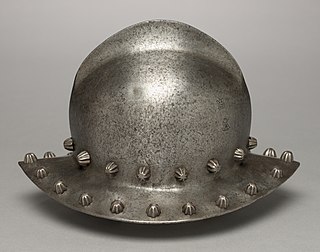
A kettle hat, also known as a war hat, is a type of helmet made of iron or steel in the shape of a brimmed hat. There are many design variations. The only common element is a wide brim that afforded extra protection to the wearer. It gained its common English language name from its resemblance to a metal cooking pot. The kettle hat was common all over Medieval Europe. It was called Eisenhut in German and chapel de fer in French.

The great helm or heaume, also called pot helm, bucket helm and barrel helm, is a helmet of the High Middle Ages which arose in the late twelfth century in the context of the Crusades and remained in use until the fourteenth century. The barreled style was used by knights in most European armies between about 1220 to 1350 AD and evolved into the frog-mouth helm to be primarily used during jousting contests.
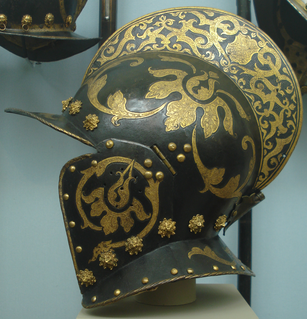
The burgonet helmet was a Renaissance-era and early modern combat helmet. It was the successor of the sallet.

The lobster-tailed pot helmet, also known as the zischägge, horseman's pot and harquebusier's pot, was a type of post-Renaissance combat helmet. It became popular in Europe, especially for cavalry and officers, from c. 1600; it was derived from an Ottoman Turkish helmet type. The helmet gradually fell out of use in most of Europe in the late 17th century; however, the Austrian heavy cavalry retained it for some campaigns as late as the 1780s.

The Spangenhelm, or segmented helmet, was a popular medieval European combat helmet design of Late Antiquity and the Early Middle Ages. They are often contrasted with Eastern lamellar helmets.

The Byzantine army of the Komnenian era or Komnenian army was the force established by Byzantine emperor Alexios I Komnenos during the late 11th/early 12th century, and perfected by his successors John II Komnenos and Manuel I Komnenos during the 12th century. From necessity, following extensive territorial loss and a near disastrous defeat by the Normans of southern Italy at Dyrrachion in 1081, Alexios constructed a new army from the ground up. This new army was significantly different from previous forms of the Byzantine army, especially in the methods used for the recruitment and maintenance of soldiers. The army was characterised by an increased reliance on the military capabilities of the immediate imperial household, the relatives of the ruling dynasty and the provincial Byzantine aristocracy. Another distinctive element of the new army was an expansion of the employment of foreign mercenary troops and their organisation into more permanent units. However, continuity in equipment, unit organisation, tactics and strategy from earlier times is evident. The Komnenian army was instrumental in creating the territorial integrity and stability that allowed the Komnenian restoration of the Byzantine Empire. It was deployed in the Balkans, Italy, Hungary, Russia, Anatolia, Syria, the Holy Land and Egypt.

The nasal helmet was a type of combat helmet characterised by the possession of a projecting bar covering the nose and thus protecting the centre of the face; it was of Western European origins and was used from the late 9th century to at least c. 1250.

Bases are the cloth military skirts, generally richly embroidered, worn over the armour of later men-at-arms such as French gendarmes in the late 15th to early 16th century, as well as the plate armour skirt later developed in imitation of cloth bases for supplemental upper-leg protection, worn by men-at-arms for foot combat.

A coat of plates is a form of segmented torso armour consisting of overlapping metal plates riveted inside a cloth or leather garment. The coat of plates is considered part of the era of transitional armour and was normally worn as part of a full knightly harness. The coat saw its introduction in Europe among the warring elite in the 1180s or 1220s and was well established by the 1250s. It was in very common usage by the 1290s. By the 1350s it was universal among infantry militias as well. After about 1340, the plates covering the chest were combined to form an early breastplate, replacing the coat of plates. After 1370, the breastplate covered the entire torso. Different forms of the coat of plates, known as the brigandine and jack of plates, remained in use until the late 16th century.
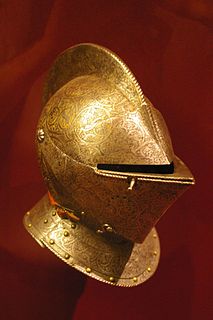
The close helmet or close helm is a type of military helmet that was worn by knights and other men-at-arms in the Late Medieval and Renaissance eras. It was also used by some heavily armoured, pistol-armed, cuirassiers into the mid 17th century. It is a fully enclosing helmet with a pivoting visor and integral bevor.

In heraldic achievements, the helmet or helm is situated above the shield and bears the torse and crest. The style of helmet displayed varies according to rank and social status, and these styles developed over time, in step with the development of actual military helmets. In some traditions, especially German and Nordic heraldry, two or three helmets may be used in a single achievement of arms, each representing a fief to which the bearer has a right. For this reason, the helmets and crests in German and Nordic arms are considered to be essential to the coat of arms and are never separated from it.

Warfare in Medieval Poland covers the military history of Poland during the Piast and Jagiellon dynasties.
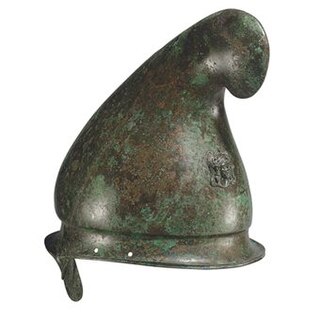
The Phrygian helmet, also known as the Thracian helmet, was a type of helmet that originated in ancient Greece and was widely used in Thrace, Dacia, Magna Graecia and the Hellenistic world until well into the Roman Empire.

The Coventry Sallet is a 15th-century helmet now on display at Herbert Art Gallery and Museum. English sallets have been considered both rare and important.
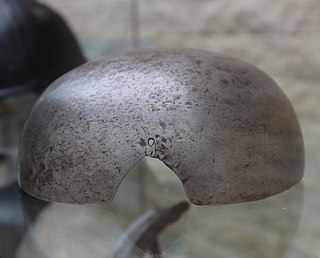
The secrete or secret, a French term adopted into English usage, was a type of helmet designed to be concealed beneath a hat.
| Wikimedia Commons has media related to Enclosed helmets . |